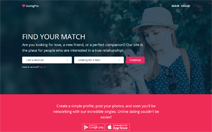Niches: their classification and how to select one N20
We recommend that you use Jobs to be Done is a theory of consumer action
☝️ Guide: How to make money on dating sites by developing a dating product
Additionally, it will help you
Use our Dating Site Customer Profile sheet to get a better understanding of your target audience
The following template will help you create customer profiles (or avatars) for your business. Before you begin, you’ll need to define the type of customer you’re profiling. It can be your most loyal customers or customers who are fans of a particular product, etc. These are just a few ideas. Get creative, and don’t worry if you change this later.
Demographics
What is the typical age range of this customer? _________________
Keep this range under 20 years, else you may be trying to squeeze customers together who would instead be better-suited in their own group.
- What is their gender? _________________
- Choose male, female or both/not applicable. If your profile includes both men and women, make sure your product and marketing materials are, in fact, gender-neutral. Otherwise, break this out into two separate profiles – one for men and one for women.
- What is their level of education? _______________________
- Some high school, high school, some college, undergraduate or postgraduate.
- What is their occupation? _______________________
- If you can’t get specific, think broader categories: Office jobs, hospitality, work outdoors, medical, construction/labor, self-employed, etc.
- Where do they live? _____________________________
- Pinpoint a specific city or neighborhood. Do they live in a single-family home, apartment, condo or townhouse?
- What is their race or ethnic origin? ___________________
- Though not always relevant, race/ethnicity can be important for some businesses.
In the space below, add any more relevant demographic detail.
Some examples might include: Do they have a specific body type or hair color? Do they drive a particular car? Do they practice a particular religion?
For example
Psychographics
Now onto the trickier part: Psychographics involve the mental characteristics of your customers: Their goals, beliefs, motivations and anxieties. This generally takes a bit more research than demographics since you’ll need to speak with customers to find these answers or just put yourself in their shoes.
Actionable Insight
Now the fun part:
It’s time to pull everything together and start creating plan. How are you going to market to this customer, and what products are you going to sell to them?
- 1. What are the best ways to reach this customer?
- I.e. Google, Twitter, Pinterest, in-store promotions, sidewalk promotions, etc.2.
- 2. What types of promotions are going to engage this customer?
- Are they going to be encouraged by coupons/discounts? If so, how much? Do you need to focus more on other promotions like new products or seasonal products/events?
- 3. What types of promotions are NOT going to engage this customer?
- Along the same lines: Is there a specific channel or promotion that will not work for this customer? Should you avoid direct mail or Facebook advertising?
- 4. What new products are going to interest this customer?
- Do they prefer a particular product/service? What potential changes could you make to encourage them further?
Defining Target Audience
There are some steps you should take before you start with a deep target audience research – define common characteristics of your average buyer.
Surveys
Conducting customer surveys is a great way to get valuable insight into consumer’s mind. However, if you plan to invest your time into it, you better have a plan.
1. Define the goals of your surveyDefining the information you want to get from your customers will help you craft the questions that reflect those goals.
2. Define who you want to surveyYou may want to adjust your targets depending on the outreach channels you have at your disposal. You can try to engage:
• Your friends or people interested in your niche
• Regular users (if you already have a website)
• Your social media followers
• All of the above
3. Decide how will you reach out to themHere are some options you may want to consider: • Send the survey to your email list • Share it across your social media channels
4. Decide which tool will you use to conduct the surveyThe more popular tools on the market that can do this job well:
• Google Forms
• Survey Gizmo
• Survey Monkey
• Typeform
• Survey Anyplace
Social Networks
If you know where to look at, social media metrics can give you a valuable insight into your customer pain points and what kind of content are they interested in general.
Facebook Insights
There is no point in trying to manually check anything on your FB fan page when Facebook tracks all the statistics you’ll ever need.Now, FB Insights can be a post for itself so we won’t go into too many technical details. There are a lot of great guides out there you can check out if you need more info.
Besides demographics data, the most useful section you should pay attention to, in the context of analyzing your customer’s pain points and interests, is the Posts tab. You can check which kind of posts (link, photo or video) attracted the most engagement (Reactions, Comments & Shares) on average.By looking at your top performing content, you could find a clue to what your followers want to know more about.
Groups
Another great way to find out what is troubling your target audience is to find and join groups in which people discuss your area of interest.Finding these groups can be quite challenging, at least finding the ones where you can get some valuable feedback. You’ll probably join and leave 10 spammed ones before you stumble upon something worthwhile.
X Twitter Analytics
The story is the same as it is with FB Insights. A lot of useful demographic information about your audience, but you want to concentrate on a few metrics that may point to their pain points.
Again, you want to look at the top performing content. You can do that by selecting the Top tweets tab while you are under the Tweets section.Since we only focused on pain points in this section, we only touched on a few selected metrics. Both Facebook and Twitter have a lot of data about their users you can use to see what resonates with your audience the best. We highly recommend allocating some time to carefully go through everything they offer.
Look at what your competition does on social media
If you have some time to spare (or you don’t have enough followers to have a valid sample) you may want to look at what are your main competitors doing on social media.
Look at the type of content that gets the most engagement as that is something you may want to replicate and improve upon in the future since your target audience is obviously interested in it.
Quora
Quora is a Q&A website – a glorified forum that covers all kinds of topics. It is on the rise for a few years now and last year it hit 100 million users mark.
The real boom happened when bloggers and marketers figured out they can get a decent referral traffic by answering selected questions and building up a following. Because of that, you will encounter mountains of biased answers you have to take with a grain of salt.This is just a minor inconvenience since we’re way more interested in the questions then we are in the answers.What makes Quora useful for the target audience research is that it covers a wide area of different topics and has a very user-friendly interface that allows you to go through a lot of questions in a short period of time.However, not every question brings in the same value. That is why we have Question Stats. Knowing the number of views and users that are following a question tells you how many people are interested in this particular problem.
As the largest platform of aggregated content and community discussion, as well as a member of top 10 largest websites in the world, Reddit is a force to be reckoned with. With so many users and such a large pool of topics covered, you are bound to find some relevant information on almost anything.
Find the subject you are interested in and look at discussions. Since this is also a Q&A site, you can quickly browse through questions and take a closer look at the ones that seem interesting and the ones that have a lot of comments.Take some time to browse around. It is highly likely you’ll encounter questions that may lead to the pain points you’re searching for.




